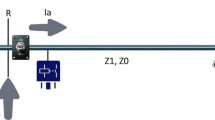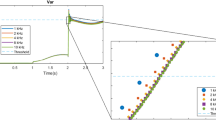Abstract
Power swing leads to mis-operation of distance relays due to variations in system current (I) and voltage (V) magnitudes. PSB function is crucial to distinguish power swing and fault properly and prevent relay pickup during power swings to avoid unintended outage of the transmission lines. Moreover, the relay should initiate trip command in case of fault during power swing. This paper introduces a prediction based PSB function to block the relay operation during power swing and also to unblock it in case of occurrence of a fault during power swing. This method predicts current and voltage samples during power swing using auto-regression technique and subsequently calculates the predicted impedance observed by the distance relay (V/I). Blocking is invoked if predicted impedance is inside the distance relay protection zones. The differential components computed using actual and predicted values are used to detect fault in the transmission system. The proposed method is tested for two-area four-machine power system and compared with available methods.






Similar content being viewed by others
References
Apostolov AP, Tholomier D, Richards SH (2004) Superimposed components based sub-cycle protection of transmission lines. IEEE PES Power Syst Conf Expos 1:592–597
Benmouyal G, Hou D, Tziouvaras D (2004) Zero-setting power swing blocking protection. In: The 31st annual western protective relay conference, Washington, 2004
Brahma SM (2007) Distance relay with out-of-step blocking function using wavelet transform. IEEE Trans Power Deliv 22(3):1360–1366
Esmaeilian A, Ghaderi A, Tasdighi M, Rouhani A (2011) Evaluation and performance comparison of power swing detection algorithms in presence of series compensation on transmission lines. In: IEEE international conference on environment and electrical engineering, pp 1–4, May 2011
IEEE Power System Relaying Committee of the IEEE Power and Energy Society (2005). Power swing and out-of-step considerations on transmission line. Rep. PSRC WG D6, July 2005. http://www.pes-psrc.org
Khoradshadi-Zadeh H (2005) Evaluation and performance comparison of power swing detection algorithms. IEEE Power Eng Soc Genetic Meet 2:1842–1848
Kundur P (1994) Power system stability and control. McGraw Hill, New York
Lin X, Gao Y, Liu P (2008) A novel scheme to identify symmetrical faults occurring during power swings. IEEE Trans Power Deliv 23(1):73–78
Lin X, Li Z, Ke S, Gao Y (2010) Theoretical fundamentals and implementation of novel self-adaptive distance protection resistant to power swings. IEEE Trans Power Deliv 25(3):1372–1383
Lotfifard S, Faiz J, Kezunovic M (2010) Detection of symmetrical faults by distance relays during power swings. IEEE Trans Power Deliv 25(1):81–87
Martuscello L, Krizauskas E, Holbach J, Lu Y (2009) Tests of distance relay performance on stable and unstable power swings reported using simulated data of the August 14th 2003 system disturbance. In: IEEE 62nd annual conference on protective relay engineering, pp 236–255, May 2009
Mooney JPE, Fischer N (2006) Application guidelines for power swing detection on transmission systems. Power system conference, PS-2006, pp 159–168
Rao JG, Pradhan AK (2012) Differential power-based symmetrical fault detection during power swing. IEEE Trans Power Deliv 27(3):1557–1564
Rao JG, Pradhan AK (2015) Power-swing detection using moving window averaging of current signals. IEEE Trans Power Deliv. Available in early access, doi:10.1109/TPWRD.2014.2342536
Seethalekshmi K, Singh SN, Srivastava SC (2010) SVM based power swing identification scheme for distance relays. IEEE power energy society general meeting, pp 1–8, July 2010
Tziouvaras D (2006) Relay performance during major system disturbances. http://www.selinc.com
Wu X, Zhao J, Xu A, Deng H, Xu P (2011) Review on transient stability prediction methods based on real time wide-area phasor measurements. IEEE—DRPT 4th international conference, Shandong, pp 320–326, July 2011
Author information
Authors and Affiliations
Corresponding author
Appendix
Appendix
The parameters of the two-area four machine system used for simulation (Fig. 3) are given below (Kundur 1994).
1.1 Generators G1, G2, G3, G4
900 MVA, 20 kV, 50 Hz each
H = 6.5 (for G1, G2) H = 6.175 (for G3, G4)
Xd = 1.8, Xq = 1.7, Xl = 0.2, X′d = 0.3, X′q = 0.55, X″d = 0.25, X″q = 0.25, Ra = 0.0025, T′d0 = 0.158 s T′q0 = 0.4 s, T″do = 0.03 s, T″qo = 0.05 s, ASat = 0.015 BSat = 9.6, \(\varPsi\) T1 = 0.9, KD = 0
1.2 Transformer
900 MVA and 20/230 kV base,
R = 0pu, X = j0.15 pu
1.3 Transmission lines
100 MVA, 230 kV base
R = 0.0001 pu/km, XL = 0.001 pu/km, BC = 0.00175 pu/km
-
Bus 7: PL = 967 MW, QL = 100 MVAr, Qc = 200 MVAr
-
Bus 9: PL = 1767 MW, QL = 100 MVAr, Qc = 350 MVAr
The system is operating with area 1 exporting 400 MW to area 2, and the generating units are loaded as follows:
-
G1: P = 700 MW, Q = 185 MVAr, Et = 1.03 ⌞20.2°
-
G2: P = 700 MW, Q = 235 MVAr, Et = 1.01 ⌞10.5°
-
G3: P = 719 MW, Q = 176 MVAr, Et = 1.03 ⌞−6.8°
-
G4: P = 700 MW, Q = 202 MVAr, Et = 1.01 ⌞−17.0°
Rights and permissions
About this article
Cite this article
Koteswara Rao, A.V., Ahmad, A. Power swing blocking (PSB) function for distance relay using prediction technique. Int J Syst Assur Eng Manag 8, 301–307 (2017). https://doi.org/10.1007/s13198-016-0434-2
Received:
Revised:
Published:
Issue Date:
DOI: https://doi.org/10.1007/s13198-016-0434-2




